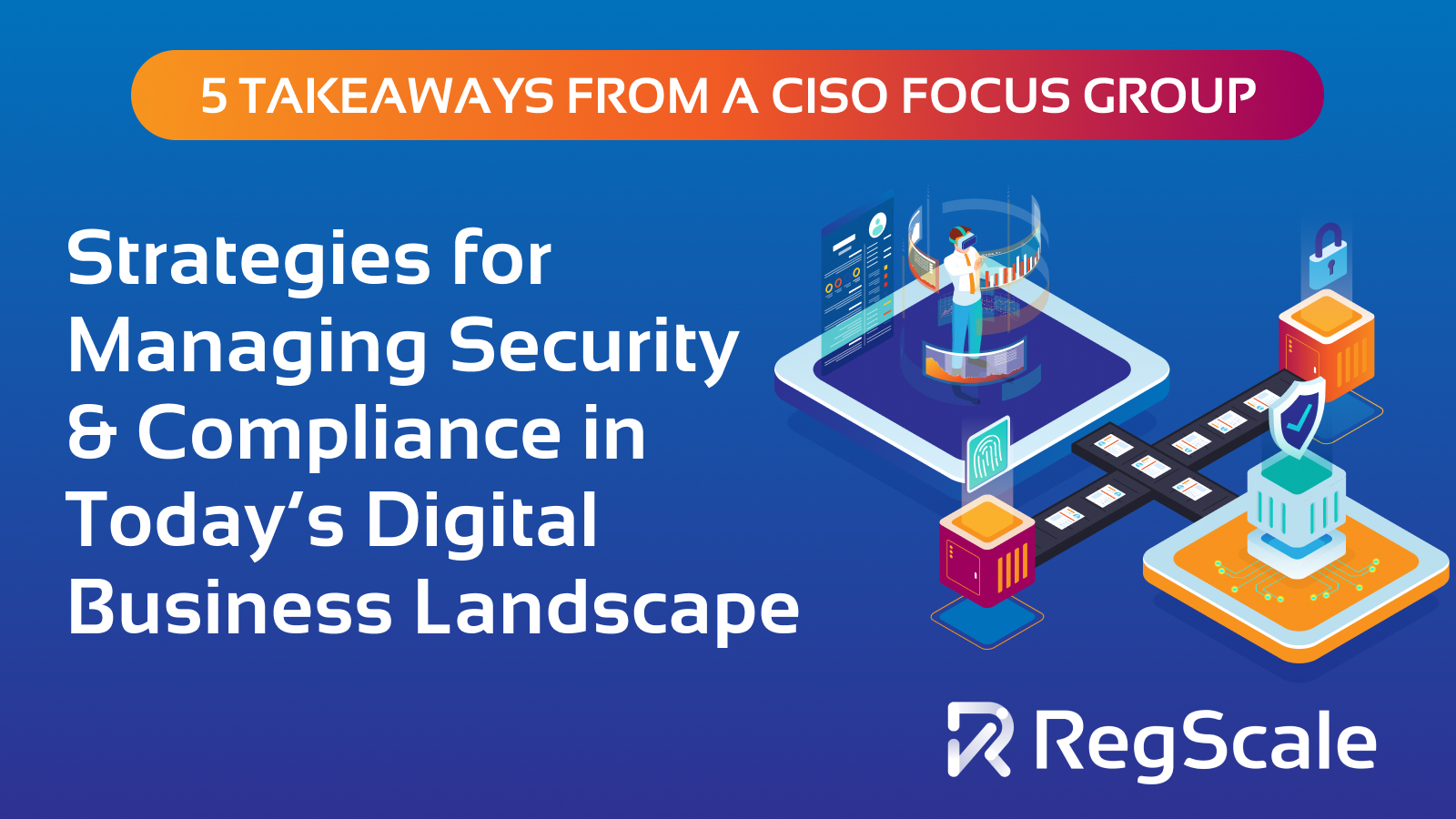5 Takeaways from a CISO Focus Group: Strategies for Managing Security and Compliance in Today’s Digital Business Landscape

Everyone recognizes that in today’s rapidly evolving business landscape, security AND compliance have become central to the success and sustainability of organizations. In an effort to gain an understanding of the customers we serve, RegScale made the decision to host a CISO Focus Group in D.C. As technology advances and threats grow in sophistication, understanding the integral role of security, navigating risk and compliance complexities, adapting to new evidence-collection approaches, streamlining access reviews, and managing organizational risk are paramount for businesses.
In this blog, we will delve into five key takeaways that shed light on these critical aspects.
1. The Integral Role of Security in Business Success
Security is no longer a choice; it’s a necessity for business success. The evolving threat landscape demands continuous controls monitoring and a proactive stance on security. However, it’s not just about technical measures. Security needs to be value-driven and should address cultural barriers within organizations. These include silos of knowledge and operation, where priorities are often developed without understanding of other functions. Security may have very different perceptions of risks and priorities for treatment than other departments who may downplay potential threats. The need for rapid innovation may be offset by demands for stringent security checks. Effective integration and communication strategies are vital for security professionals to align security goals with the overall objectives of the business.
2. The Complexity of Risk & Compliance
The interplay between risk and compliance is intricate. Achieving a unified approach to risk management and compliance is essential, especially given the unique challenges that different industries face. Consider biotech and financial services.
Protecting and preserving research data in biotech is essential to organizational success. The biotech industry, driven by innovation and ground-breaking discoveries, holds sensitive information that can shape the future of medical advancements and treatments. A breach or loss of this data not only jeopardizes the integrity of ongoing research but can also lead to intellectual property theft, negatively affecting the organization’s competitive edge. Moreover, with the increasing number of collaborations and partnerships in this field, ensuring data privacy becomes even more critical. Effective risk and compliance management can safeguard these valuable assets, ensuring that they remain confidential and unaltered.
In the world of financial services, adhering to regulations is not just about compliance – it’s paramount to the industry’s trustworthiness and stability. Financial institutions handle large amounts of personal and transactional data daily. A slight oversight or deviation from the established guidelines can result in significant repercussions, both in terms of financial penalties and damaged reputations. Regulators in this industry are not just overseers; they can be viewed as threat actors. Institutions must stay ahead, treating regulators as they would any other risk, ensuring that all practices and procedures are continuously monitored and regularly updated to meet the ever-evolving regulatory landscape.
Understanding these complexities and bridging the language gap between security, compliance, and other organizational units is crucial for effective risk mitigation and compliance adherence. Clear communication and a shared understanding of controls are imperative in navigating these complexities.
3. The Evolving Landscape of Evidence Collection
The landscape of evidence collection is shifting. Organizations need to decide between centralizing compliance efforts and adapting to diverse contexts. Automation is an aspiration, but its potential pitfalls and the ongoing debate around cloud, hybrid, and on-premises systems add layers of complexity. Newer, start-up companies will largely be “cloud-native” which lends to further automation and centralization of compliance processes. Others are moving towards a hybrid model or on-prem due to cost and regulatory factors. Storing data in the cloud can prove to be significantly more expensive than using private data centers, and in some industries, regulators are a potential obstacle for moving data and business fully into cloud environments. Striking the right balance while considering contextual appropriateness is key to an effective evidence-collection strategy.
4. Challenges and Considerations in Access Reviews
Access Reviews pose significant challenges due to the manual nature of the process, the diversity and separation of data systems within an organization, and the absence of a consistent “source of truth” for what is acceptable access. Understanding precise access privileges and their implications is critical to effective access reviews. Identity and Access Management (IAM) technologies play a pivotal role in managing access to critical systems and intellectual property. It’s essential to contextualize “access review” concerning access to networks, applications, systems, and protected data, including intellectual property, to enhance compliance objectives.
5. Navigating the Nuances of Organizational Risk
Defining terms like “Risk,” “Threat,” and “Vulnerability” presents a persistent challenge. Controls and their validation are gaining importance in risk management to provide assurance and mitigate vulnerabilities. Adopting a multi-faceted approach to risk management, encompassing compliance risk, enterprise risk, third-party risk, and the emerging “Product Risk” perspective, ensures a comprehensive understanding and proactive management of organizational risk.
In today’s dynamic business environment, mastering security and compliance is about understanding the evolving landscape and embracing innovation while mitigating risks. Implementing and managing controls, complemented by continuous monitoring, provides a holistic approach to support good security, risk, and compliance. By addressing these key takeaways and adopting effective strategies, businesses can create a pervasive culture of security and compliance at all levels. This culture is the bedrock upon which organizations, regardless of their industry, can navigate the complexities of the digital era, laying a robust foundation for growth and sustainability.
Ready to get started?
Choose the path that is right for you!
Skip the line
My organization doesn’t have GRC tools yet and I am ready to start automating my compliance with continuous monitoring pipelines now.
Supercharge
My organization already has legacy compliance software, but I want to automate many of the manual processes that feed it.